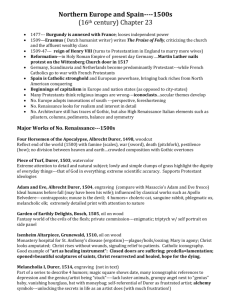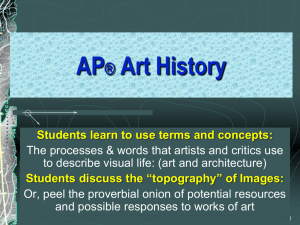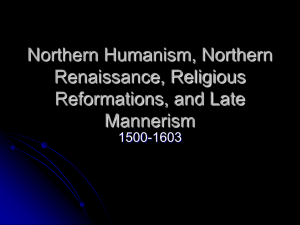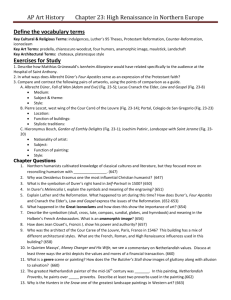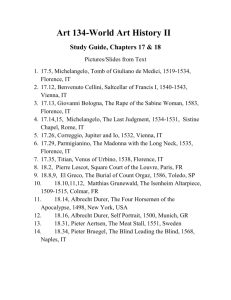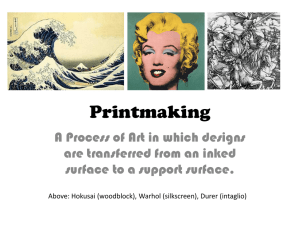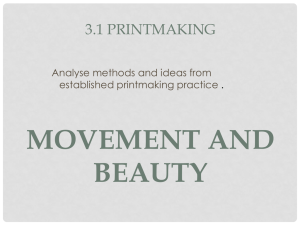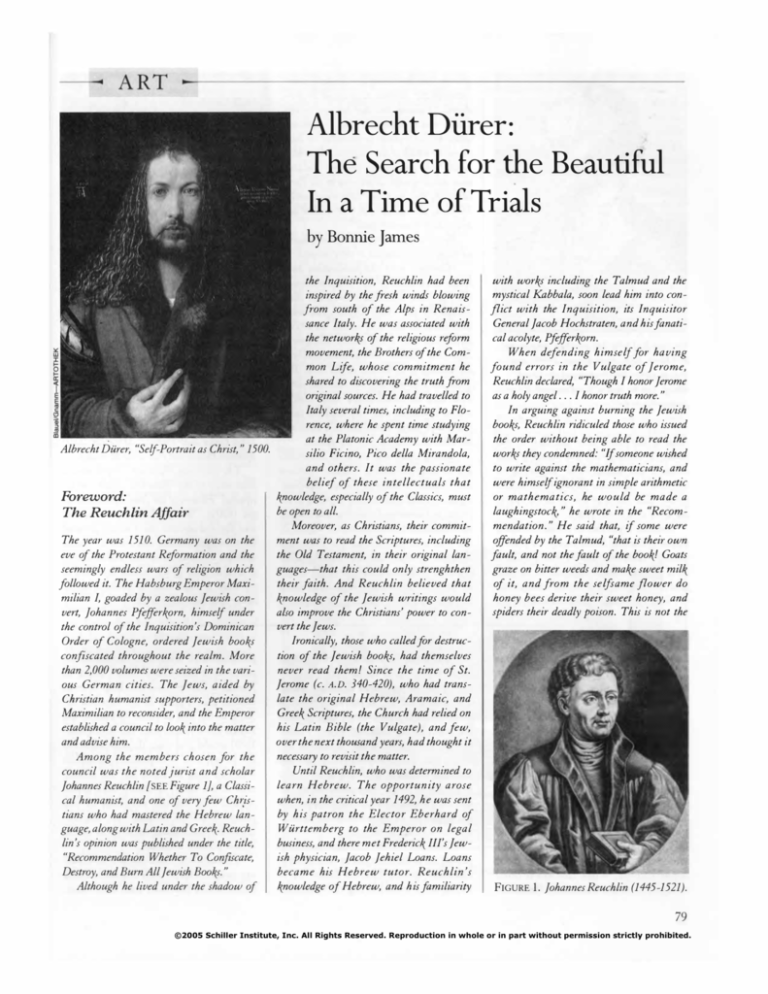
-.,-.
A RT
.. --------------------�
Albrecht Durer:
The Search for the Beautiful
In a Time of Trials
by Bonnie James
the Inquisition, Reuchlin had been
inspired by the fresh winds blowing
from south of the Alps in Renais­
sance Italy. He was associated with
the networks of the religious reform
movement, the Brothers of the Com­
mon Life, whose commitment he
shared to discovering the truth from
original sources. He had travelled to
Italy several times, including to Flo­
rence, where he spent time studying
at the Platonic Academy with MarAlbrecht Durer, "Self-Portrait as Christ, " 1500.
silio Pieino, Pico della Mirandola,
and others. It was the passionate
belief of these intellectuals that
knowledge, especially of the Classics, must
Foreword:
be open to all.
The Reuchlin Affair
Moreover, as Christians, their commit­
ment was to read the Scriptures, including
The year was 1510. Germany was on the
the Old Testament, in their original lan­
eve of the Protestant Reformation and the
guages-that this could only strenghthen
seemingly endless wars of religion which
their faith. And Reuchlin believed that
followed it. The Habsburg Emperor Maxi­
knowledge of the Jewish writings would
milian I, goaded by a zealous Jewish con­
also improve the Christians' power to con­
vert, Johannes Pfefferkorn, himself under
vert the Jews.
the control of the Inquisition's Dominican
Ironically, those who called for destruc­
Order of Cologne, ordered Jewish books
tion of the Jewish books, had themselves
confiscated throughout the realm. More
never read them! Since the time of St.
than 2,000 volumes were seized in the vari­
Jerome (c. A.D. 340-420), who had trans­
ous German cities. The Jews, aided by
late the original Hebrew, Aramaic, and
Christian humanist supporters, petitioned
Greek Scriptures, the Church had relied on
Maximilian to reconsider, and the Emperor
his Latin Bible (the Vulgate), and few,
established a council to look into the matter
over the next thousand years, had thought it
and advise him.
necessary to revisit the matter.
Among the members chosen for the
Until Reuchlin, who was determined to
council was the noted jurist and scholar
learn Hebrew. The opportunity arose
Johannes Reuchlin [SEE Figure I}, a Classi­
when, in the critical year 1492, he was sent
cal humanist, and one of very few Ch�is­
by his patron the Elector Eberhard of
tians who had mastered the Hebrew lan­
Wurttemberg to the Emperor on legal
guage, along with Latin and Greek. Reuch­
business, and there met Frederick Ill's Jew­
lin's opinion was published under the title,
ish physician, Jacob Jehiel Loans. Loans
"Recommendation Whether To ConfIScate,
became his Hebrew tutor. Reuchlin's
Destroy, and Burn All Jewish Books. "
knowledge of Hebrew, and his familiarity
Although he lived under the shadow of
with works including the Talmud and the
mystical Kabbala, soon lead him into con­
flict with the Inquisition, its Inquisitor
General Jacob Hochstraten, and his fanati­
cal acolyte, Pfefferkorn.
When defending himself for having
found errors in the Vulgate of Jerome,
Reuchlin declared, "Though I honor Jerome
as a holy angel . . . I honor truth more. "
In arguing against burning the Jewish
books, Reuchlin ridiculed those who issued
the order without being able to read the
works they condemned: "Ifsomeone wished
to write against the mathematicians, and
were himself ignorant in simple arithmetic
or mathematics, he would be made a
laughingstoc�" he wrote in the "Recom­
mendation. " He said that, if some were
offended by the Talmud, "that is their own
fault, and not the fault of the book! Goats
graze on bitter weeds and make sweet milk
of it, and from the selfsame flower do
honey bees derive their sweet honey, and
spiders their deadly poison. This is not the
FIGURE 1. Johannes Reuchlin (1445-1521).
79
©2005 Schiller Institute, Inc. All Rights Reserved. Reproduction in whole or in part without permission strictly prohibited.
fault of the blossom or the flower, but
rather the characteristic and nature of those
creatures that feed on them. " Reflecting his
Christian humanist outlook, Reuchlin
wrote, "The Jew is as worthy in the eyes of
our Lord God even as am l. "
Reuchlin urged that his fellow Christians,
instead of burning books, engage the Jews in
reasoned discourse, and in that way, win
them over to what he regarded as the true
faith. He proposed that German universities
hire lecturers to teach Hebrew. He also urged
Jews to rent their books to Christians, until
copies of the Hebrew texts could be pro­
duced. "I assure you that not one of the
Latins can expound the Old Testament,
unless he first becomes proficient in the lan­
guage in which it was written, " Reuchlin
wrote. "For the mediator between God and
man was language, as we read in the Pen­
tateuch; but not any language, only
Hebrew, through which God wished his
secrets to be known to man. "
Reuchlin prevailed, and the confiscat­
ed books were returned to their owners.
However, with the publication and
wider circulation of his "Recommenda­
tion" in 1511, Reuchlin came under sus­
picion by the Holy Office. He was
labelled a heretic, and worse. In 1514,
Reuchlin's most bitter enemy, Cologne's
Inquisitor General Hochstraten, ordered
his writings to be burned at the stake. By
1520, the Pope himself, the Venetian cat's
paw Leo X, condemned Reuchlin's
works. It is likely that only his death two
years later saved Reuchlin, still loyal to
the Church at Rome, from the flames.
Among those who came to Reuchlin's
defense were the leading religious reformers
and Classical scholars of Europe, represent­
ing diverse and often bitterly opposing view­
points: in Germany, his nephew and student,
the theologian Melanchthon [SEE Figure 2};
the man who spearheaded the Protestant
Reformation and break with Rome, Martin
Luther; the most prominent Christian
humanist intellectual in Europe, Erasmus of
Rotterdam [SEE Figure 3}; in England,
s the 1400's, the century of the
"Golden Renaissance," drew to
a close, Europe was plunged
into a profound crisis, from which it did
not begin to emerge until the middle of
the Seventeenth century. Beginning
with the 1492 expulsion of the Jews
from Spain, at the order of the Grand
Inquisitor Tomas de Torquemada, and
ending with the 1648 Peace of West­
phalia, which brought an end to the
Thirty Years' War-the final phase of
this prolonged nightmare-the period
was chara.cterized by the destruction
and dep6pulation of entire regions
across Europe. While this era is often
referred to as the Protestant Reforma-
tion and Catholic Counter-Reformation,
these labels tend to obscure the true
nature of the upheaval that took place.
The extended social-cultural-political
devastation that overcame Europe was
the intended outcome of Venice's mur­
derous war against the Renaissance.
What the Venetian oligarchy did not
know, was how it would end-with the
emergence, albeit long-delayed, of the
sovereign nation-state, established on
the principle of the sacredness of each
individual human life.
At the start of this turbulent historical
period, an artist emerged in Nuremberg,
Germany, named Albrecht DUrer (14711528), who would bring the Classical
FIGURE 2. Philip Melancthon, engraving
by Durer, 1526. Inscription: "Durer was
able to picture the features of the living
Philip, but his skilled hand was unable to
picture his mind. "
A
80
FIGURE 3. Erasmus of Rotterdam, engraving
by Durer, 1526. Inscription: "His writings
present a better picture of the man than this
portrait. "
John Colef and Thomas More; in Italy,
Marsilio Ficino and Pico della Mirandola.
The historian Heinrich Graetz would
later write of the "Reuchlin Affair, " in his
seminal "History of the Jews" (published in
the 1870's): "We can boldly assert that the
war for and against the Talmud aroused
German consciousness and created a public
opinion, without which the Refbrmation,
as well as other efforts, would have died at
the hour of their birth, or perhaps would
never have been born at all. "
philosophical, scientific, and' humanist
ideas of Fiftee nth-century Italy to
Northern Europe, and thus help to set in
motion a new phase of the Renaissance.
And, at the end of these 150 years, the
Dutch artist Rembrandt van Rijn (16061669) would give voice through his art to
the principle of Westphalia: that human
relations must be based on "the advan­
tage of the other." Notably, both artists
would rely on the medium of the
.
print-woodcuts, etchings, and engrav­
ings-to disseminate these ideas to the
widest possible audience.
Through his hundreds of revolution­
ary prints, DUrer both chronicled and
transformed his time, such that today,
when one thinks about those years, the
images he created are the visual
metaphors that come to mind. The
power of these images was reaffirmed in
a superb exhibition this past fall at the
Virginia Museum of Fine Arts in Rich­
mond, where 83 of the master's greatest
woodcuts, etchings, and engravings
were on display. Accompanying the
works, were two excellent pedagogical
displays: one on printmaking, and
another on Durer's famous perspective
experiment [SEE Figure 4], in which the
visitor was invited to reproduce that
experiment for himself.l
Education of a Humanist Artist
In 1494,Durer made his first trip to Italy.
He had already, following his apprentice­
ship with Nuremberg's leading painter,
Michael Wolgemut, made an extended
tour (1490-1494) through Germany, to
Bas�l, Switzerland, a center of humanist
activity; to Alsace, where he stayed with
the sons of the painter Martin Sch6n­
gauer; and to Strasbourg and the Low
Countries as well. There he met Sebast­
ian Brant and produced several wood­
prints for his book, The Ship of Fools. One
of these prints presents St. Jerome in his
studio with books in Hebrew, Greek,
and Latin. Nuremberg was then one of
the leading cities in Germany; by 1520, its
population would rise to 50,000, and it
boasted a large and thriving class of arti­
sans and merchants. Durer's father
Albrecht was a skilled goldsmith (like the
fathers of many Florentine artists, includ­
ing Brunelleschi), who had emigrated
with his family-Albrecht was third of
18 children!-from Hungary to Nurem­
berg to seek a better life.
The humanist intelligentsia of
�orthern Europe was, in significant
degree, the product of the long-term
education project of the teaching order,
the Brothers of the Common Life,
founded in 1374 by Gerard Groote
(1340-1384) of Deventer in the Low
Countries. The purpose of the Brother­
hood was to uplift the population­
especially the vast numbers of the
poor-in the wake of the devastation
wrought by the Black Death, which
peaked in the mid-Fourteenth century,
and recurred in waves after that.
Among the outstanding leaders who
were later educated in the schools of the
Brotherhood were Nicolaus of Cusa and
Erasmus of Rotterdam. Groote's work
was carried on and expanded by Thomas
a Kempis (1380-1471), born in a small
town near present-day Dusseldorf in
Germany. Kerflpis's widely read book,
The Imitation of Christ, called on his stu­
dents to live their lives in imitation of
Christ, i.e., to be willing to joyfully sacri­
fice everything on behalf of a higher pur­
pose than mere mortal life, or in Christ­
ian terms, to be willing to drink from the
cup of Gesthemane. He writes, "If you
bear [the] cross against your will, you will
make a great burden for yourself . . . ," but,
"if you gladly bear this cross, it will bear
you . . . ." Rejection of worldly wealth, in
favor of a community founded in imita­
tion of the simple and compassionate life
of the Jesus of the Gospels, was under­
stood as an attempt to reform the feudal
institution of the ultramontane Church
and Papacy.
These ideas would later be powerful­
ly expressed in Durer's Passion series of
woodcuts and engravings.
In line with the idea of the "imitation
of Christ," was the education program of
the Brothers, aimed at bringing learning
to children of all social classes. The
Brothers' primary objective, the educa-
tion of the children of the poor, was an
expression of their commitment to the
principle of the common good-an idea
expounded directly by Brotherhood stu­
dent Cardinal Nicolaus of Cusa (14011464) in his Concordantia C�tholica,
where he argued that the legitimacy of
government derives from the consent of
the 'governed. To accomplish this, the
Brotherhood promoted translations of
the Classics into the vernacular lan­
guages (Brotherhood schools already
focussed on the copying of manuscripts,
exposing students to the original Latin
and Greek sources). The Brotherhood
translation program followed in the foot­
steps of Italy's Dante Alighieri (c. 12651321), whose Commedia, written in an
elevated Tuscan vernacular of his own
invention, had launched the literary and
political Renaissance in Europe.
The influence of the Brotherhood
extended well into Durer's time, in the
Fifteenth and Sixteenth centuries.
Brotherhood schools across Northern
Europe enrolled as many as 1,000 stu­
dents each. When Erasmus (1466-1536)
attended the school in Deventer, its
enrollment was over 2,000 students.
The Brotherhood also played a cen­
tral role in the explosion of literacy
made possible by the invention of the
FIGURE 4. Albrecht Durer, illustration'to "Underweysung der Messung" ( "Treatise on
Measurement"), Book IV, 1525.
81
printing press circa 1450. Johannes
Gutenberg, its inventor, was a Brother­
hood associate, and trained many of the
order's laymen in the new science of
printing.2 Durer's mass-circulation of
prints was an extension of this idea.
Fifteenth-century Nuremberg
Durer's godfather, Anton Koberger
(1445-1513), was also a goldsmith, but
soon after Albrecht's birth, he established
a printing business. By 1484, about the
time that Durer began to study painting,
Koberger's firm had become one of the
most important printing enterprises in
Europe. Nuremberg was one of the first
cities in Europe to have printing presses;
it also boasted laboratories that produced
fine scientific instruments. Its libraries
were centers of humanist studies, and
attracted scholars, mathematicians, geog­
raphers, and theologians.
The finest Classical library in
Nuremberg belonged to Durer's lifelong
friend and patron Willibald Pirckheimer
[SEE Figure 5], scion of a wealthy and
accomplished family, and the city's lead­
ing humanist scholar.3 Pirckheimer's
grandfather was a friend of Nicolaus of
Cusa, and studied with him in Padua,
where Willibald later attended the uni­
versity. Durer also was a follower of the
mathematician and astronomer Johannes
Muller, known as Regiomontanus (14361476), himself a follower of Cusa. Pirck­
heimer acquired Regiomontanus's exten­
sive library, which included works by
Archimedes, Euclid, and Alhazen, after
his death in 1496; Durer had access to this
library, and perhaps it was here that he
first learned about perspective, from the
works of the great Florentine architect
and mathematician Filippo Brunelleschi.
Christopher Columbus reportedly sailed
with the star maps of Regiomontanus.
In 1509, Durer purchased a house
(now known as the Durer House) in
Nuremberg, which had belonged to a
disciple of Regiomontanus, Bernhard
Walther (1430-1504). Walther's equip­
ment remained in the house (which still
retains the window through which he
sighted the heavens), as did his library,
bought by the Nuremberg city council
and mad�' available to practitioners of
astronomy. In 1514, the mathematician
and astronomer Johannes Werner used
82
FIGURE 5. Willibald Pirckheimer,
engraving by Durer, 1524. Inscription:
"Man lives through his intellect; all else
will belong to death. "
this library while writing a treatise on
conic sections.4
It was Pirckheimer who introduced
Durer to the leading circle of humanists
in Europe, including Erasmus, who was
Pirckheimer's lifelong correspondent; to
Melanchthon and Martin Luther; and to
the powerful as well-the Habsburg
Emperor Maximillian I, and later, his
grandson Charles V. Not only did Pirck­
heimer open his unparalleled library to
Durer, but he also translated many
works from Greek and Latin into Ger­
man for him.
On his two known visits to Italy,
Durer collaborated with the leading
artists of the time, including RaphaeP
Similarly, the Italian artist Jacopo de'
Barbari visited Nuremberg in 1500, and
met with him. It is quite possible that de'
Barbari spoke with Durer about the work
of Leonardo, who was at that time begin­
ning his studies with the famous mathe­
matician Luca Pacioli, as during his sec­
ond trip to Italy in 1505-07, Durer wrote
to Pirckheimer that he would travel to
Bologna (just 65 miles north of Florence),
"to learn the secrets of the art of perspec­
tive, which a man is willing to teach me."
This would most likely have been Pacioli,
who had himself learned geometry from
Piero della Francesca, and who taught it
to Leonardo. Leonardo drew the illustra­
tions of the Platonic solids for Pacioli's
mathematical treatise, De Divina Propor­
tione, published in Venice in 1509, which
Durer studied. In this work, Pacioli
argues that scientific perspective entitles
painting to be considered a mathematical
discipline, like music.
, Venice, where Durer stayed for some
months in 1494-95, was then the center of
world trade and commerce, with strong
ties to Nuremberg. Venice was also the
center of intrigue, the seat of the ancient
and evil Black Nobility descended frCUll
the old Roman aristocracy, which was
determined to eradicate the impact of the
Italian Renaissance, especially the ecu­
menical spirit exemplified by the work of
Cusa and the 1437 Council of Florence,
by unleashing a war of "each against all."
The youthful Durer took in every­
thing he could of the Italian Renaissance,
and was deeply affected by the brilliance
of its accomplishments. Durer was espe­
cially interested in the science of perspec­
tive and human anatomy, which the Ital­
ians had revived from Greek Classical
art, as well as Platonic science and phi­
losophy. He forged an especially close
relationship with' the Venetian painter
Jacopo Bellini, and his sons Gentile and
Giovanni. Along with Andrea Mantegna
(who married Jacopo's daughter
Nicolosia), they were the foremost expo­
nents of the' Renaissance in northern
Italy; thus Venice, through this Bellini­
Mantegna-Durer connection, ironically
became the transmission belt of Renais­
sance art into Northern Europe.
Durer was interested in the ,Work of
the best Italian engravers of his time,
especially Mantegna, who was the great­
est artist of northern Italy at the end of
the Fifteenth century. At the time of
Durer's first visit to Venice, Mantegna
was still alive and active as court painter
to the duke of Mantua. While in Venice
in late 1494, Durer copied two of his
prints in pen and ink. Durer was pro­
foundly influenced by Mantegna's p'rints,
because of their Classical subjects and
dramatic perspective [SEE Figure 6].
Mantegna was the only first-rank Italian
painter to have engraved a significant
number of copper plates. He would cer-
tainly have re�ognized in Durer's
engravings the work of a consummate
master; but, before Durer could reach
Mantua, Mantegna died. It has been
reported that Durer considered this to be
the saddest event of his life. His disap­
pointment was so profound, that Pirck­
heimer saw fit to mention it in Durer's
funeral oration in 1528.
Later, the works of both Mantegna
and Durer would have a profound effect
on the greatest artist of the Seventeenth
century, Rembrandt van Rijn.
Diirer Becomes a Platonist
'This great art of painting has been
held in high esteem by the mighty
kings many hundred years ago.
They made the outstanding artists
rich, and treated them with distinc­
tion, because they felt that the great
masters had an equality with God,
as it is written. For a good painter
is full of figures, and if it were pos­
sible for him to live on forever, he
would always have to pour forth
something new from the inner
ideas of which Plato writes.'
-Albrecht Durer6
By 1504, the year before Durer's sec­
ond trip to Italy, Pirckheimer boasted to
Nuremberg's poet laureate Conrad
Celtis, that he possessed all the Greek
books that had been printed in Italy up
till that time (Pirckheimer himself had
translated more than 35 Greek works
into Latin and German, and had studied
law in Padua and Pavia). His library,
and especially his original translations
from the the Greek of Plato, opened the
world of humanist knowledge to Durer.
Plato's Complete Works were first
printed in 1484, in a Latin edition based
on the translation completed by Marsilio
Ficino some 15 years earlier. The first
printed Greek edition of Plato's works
was published by Aldus Manutius, the
leading printer in Venice, in September
1513. Pirckheimer owned copies of both
books.
Durer also became acquainted with
the works of the Roman architect, engi­
neer, and scientist Vitruvius, who was
widely respected by Italian humanists­
think of Leonardo's "Vitruvian Man"­
not least because he looked back to the
Greeks and Egyptians for inspiration.
Durer asked Pirckheimer to mention,
in the preface he
wrote to Durer's Four
Books on Human Pro­
portion, "that I give
FIGURE 6. Andrea Mantegna, "St. James Led to Execution, "
Eremitani Church, Padua, c. 1453/7.
the Italians very high
praise for their nude
figures and especially
for their perspective. "
In a draft introduc­
tion to that treatise,
Durer revealed how
his interest in "human
measuremen t " had
been awakened:
"I found no one
who has written about
a system of human
proportions except
[Jacopo de' Barbari], a
native of Venice and a
lovely painter. He
showed me how to
construct man and
woman based on mea­
surements. When he
told of this, I would
rather have come into
possessIOn of his
knowledge than of a kingdom. . . . But
Jacopus I noticed did not wish to give me
a clear explanation; so I went ahead on
my own and read Vitruvius, who
describes the proportions of tqe human
body to some extent."
In the introduction to De Architectura,
Durer would have encountered Vitru­
vius's advice on the education of the
architect. His knowledge, Vitruvius
wrote, "is born of both practice and theo­
ry. . . . Neither natural ability without
instruction, nor instruction without nat­
ural ability can make the perfect artificer.
Furthermore, the architect should be let­
tered, so that he may leave a lasting
memorial in his treatises; know how to
draw; be instructed in geometry; and
know history, philosophy, music, medi­
cine, law, and astrology [astronomy
-Bn. " For the next quarter-century,
Durer sought instruction in these topics,
which enriched his practice as an artist.
In particular, he pursued beauty through
Messung ("measurement"), Durer's word
for perspective, proportion or commen­
surability, and geometry. The fruit of
this research appeared in two treatises,
Instruction in Measurement with the
Compass and Straight Edge of Lines,
Planes, and Solid Bodies (1525), and the
Four Books on Human Proportion, pub­
lished posthumously.
In the preface to Book III of his De
Architectura, Vitruvius introduces
Socrates, whom "Apollo had pro­
nounced through his priestess at Delphi
to be the wisest of men. " Vitruvius sug­
gests that, in writing "on the excellence
of our science," he was following
Socrates' advice. While still in Venice,
Durer bought a copy of the first Latin
translation of Euclid's surviving Greek
texts, including the Elements of Geometry
and Optics, to increase his access to the
discoveries of Greek mathematics.
Diirer's Prints: Mass Organizing
For the Renaissance
Durer was the first artist of Northern
Europe to understand the significance of
the Italian Renaissance, especially its foun­
dations in the Greek Classics, and particu­
larly the ideas of Plato and Socrates. He
took as his mission, to bring the ideas of
the Renaissance to the North, and to
spread them, not only to his fellow artists,
83
the son also displays his new-found mas­
with few remedies to the
tery of human anatomy, which he had
injustices that characterized
begun to study in Italy. The "Prodigal
their daily lives. The oppres­
Son" became one of the most popular of
sion of the population would
Durer's prints during his lifetime, and
soon fuel the peasant revolts
was copied by at least six Italian
that shook Central Europe
engravers. Its fame in Italy alone is
in the first decades of the
attested by its inclusion in Giorgio
Sixteenth century.
Vasari's famous Sixteenth-century Lives
As the new century
of the Artists, where it is praised as one of
approached, Durer began to
" 'Alberto Duro's' most charming and
put the lessons he had
successful prints. "
learned in Italy to work. In
1496, he produced an engrav­
The 'Apocalypse' Series
ing of the parable of the
As the new century approached, Durer
Prodigal Son [SEE Figure 7],
published, beginning in 1498, his fir.st
which already shows the
woodcut series: the "Apocalypse," based
originality of his thinking,
on the Revelation of St. John. This became
and reflects his determina­
the most celebrated event in the history of
tion to uplift his fellow man
printmaking. In fact, it was the first book
by employing the vivid lan­
to have been designed, published, and
guage of the Bible, familiar
illustrated wholly by an artist. We can be
to the most humble peasant,
sure it was intended by Durer to be a
but giving the familiar sto­
major weapon in his campaign to bring
ries a new interpretation that
the Renaissance to Northern Europe.
would catch the viewer by
FIGURE 7. "The Prodigal Son and the Swine, " 1496.
The carefully planned release of the
surprise, showing him some­
first prints, which were circulated in lim­
thing he had not seen before.
but to the population at large. Never
ited numbers prior to the release of the
The story of the prodigal son appears
before had an artist used the medium of
only in the Gospel of Luke
printing to express the most advanced and
(15:11-32), and tells of
sublime ideas through graphic images,
God's mercy for the repen­
and to disseminate them so widely. As we
have seen, DUrer was walking in the foot­
tant sinner. Traditionally,
the story is depicted by the
steps of the followers of Groote and
"happy ending," when the
Thomas a Kempis, in his commitment to
son returns home and is
reach out to the lowliest strata of the pop­
welcomed and forgiven by
ulation with the revolutionary ideas of the
his father. Durer, instead,
Renaissance: that each person is created in
shows the son at the
imago Del� in the image of the Creator,
moment of his epiphany,
and is capable of developing himself or
as he kneels in prayer, ask­
herself, to participate in the continuing
ing God's forgiveness
creation of the universe.
Until Durer's revolution, the only
among the pigs in the
barnyard (a condition that
exposure ordinary people had to great
would have been familiar
art was through the works that adorned
to Germany's peasants).
their churches. Now, Durer's master­
pieces could be reproduced in large
The son's long nose and
numbers, and sold for pennies in the
chin resemble the swine
who feed around him,
marketplace.
DUrer invented an entirely new lan­
while their expressions
mimic the bestiality of the
guage to express his ideas, a metaphori­
man who would reject the
cal language which could be "read" even
Good. Durer's message is
by an illiterate population. At this time,
clear: Man can uplift him­
only a tiny percentage of the population
self from the level of tile
could read at all; most people lived a
'
beasts, only by becoming
miserabl(l� existence as serfs, poor peas­
man in the image of God.
ants who lived as virtual slaves on the
Durer's rendering of FIGURE 8. "The Four Horsemen, " Apocalypse series, 1498.
large estates of the feudal landlords,
84
full set, was intended to intersect the
heightened interest in end-times themes
that was reaching a fever-pitch amongst
the fervently religious and highly super­
stitious population with the approach of
the year 1500.
Because, for the first time, Durer
served as his own publisher, purchasing
the paper, and paying for the printing, he
personally received the credit, and the
financial profits realized from the publica­
tion of the woodcuts. This also gave him
complete artistic control over their pro­
duction, and in so doing, established the
potential of the woodcut as an art form. It
made its creator an international celebrity.
The actual printing of the "Apoca­
lypse" (and most likely of most of Du�­
er's other woodcuts) was done at the
firm of Durer's godfather Anton
Koberger. An excerpt from a German
text 'of the Book of Revelation was print­
ed on the reverse of each print.
The "Apocalypse" was to be the first
of the three groups of woodcuts that
Durer ca'lled his "Three Great Books"
(together with the "Large Passion" and
"Life of Mary" series).
The most famous of the "Apoca­
lypse" series is "The Four Horsemen"
[SEE Figure 8], executed in 1498. The
text from Revelation reads,
"Now I saw when the Lamb opened
one of the seven seals, and I heard one of
the four living creatures say, as with a
voice of thunder: 'Come!' And I saw a
white horse, and its rider had a bow; and
a crown was given to him, and he went
out conquering.
"When he opened the second seal, I
heard the second living creature say,
'Come!' And out came another horse,
bright red; its rider was permitted to
t:i.ke peace from the earth, that men
should slay one another; and he was
given a great sword.
"When he opened the third seal, I
sa.w, and behold, a black horse, and its
rider had a balance in his hand; and I
heard what seemed to be a voice saying,
A quart of wheat for a denarius.
"When he opened the fourth seal, I
saw a 'pale horse, and its rider's name
was Death, and Hades followed him;
and they were given power over a quar­
ter of the earth, to kill with sword and
with famine and with pestilence and by
wild beasts of the earth. "
(Rev. 6:1-8).
In Durer's render­
ing, we find all the ele­
ments described in the
Bible text. Yet,.the very
fact that the terrifying
images
have been
brought to life by the
hand of the great artist,
is proof that the mind of
man is more powerful
than the fear of the
unknown! Durer, by
confronting the fear of
the oncoming "apoca­
lyptic " year 1500, has
shown the way to over­
come the terror.
It is highly signifi­
cant that the series was
reprinted in 1511: This
was the year that the
League of Cambrai­
the alliance of European
states against Venice
and its controlled Papa­ FIGURE 9. "Knight, Death, and Devil, " 1513.
cy-failed. It was an
details and amazing effects of texture
enormous setback for the humanists, an
and light.
event which fuelled the process leading
to the religious wars of the following
In "Knight, Death, and Devil" [SEE
Figure 9] (1513), Durer salutes the great
century.
humanist Erasmus of Rotterdam, whose
The Master Engravings
portrait he drew in 1520. The subject of
"Knight," is derived from Erasmus's
The "Meisterstiche" (Master Engravings)
1503 Handbook of a Militant Christian,
were Durer's three most complex prints:
which was part of his project to educate
"Knight, Death, and Devil," "St. Jerome
the princes of the realm and of the
in his Study," and "Melencolia I," pro­
church, as well as the common people, in
duced between 1513 and 1514. Since they
how to live a more Christian life. Durer's
were all done around the same time, and
Knight, wearing "the full armor of God,"
are nearly equal in size, they have always
sits upright on his horse, steadily advanc­
been g�ouped together, as a kind of coun­
ing through the grim landscape, his faith­
terpoint to Durer's three great books of
ful dog scampering underfoot. He is nei­
woodcuts. They also stand out among
ther tempted nor distracted by Death,
Durer's works for their complex subject
who rides alongside, taunting him with
matter. Whereas most of Durer's prints
the hour-glass that symbolizes man's
were meant for a wide audience, these
mortality. Behind them follows a beastly,
three were aimed instead at a more elite
horned Devil, ever ready to pounce,
circle of humanist collaborators and
should the Knight stray from the path. In
artists. The exact meaning of each­
the distance, Durer has given us a beauti­
especially "Melencolia"-has been debat­
ful Renaissance "city on a hill "­
ed since they were first published.
The three Meisterstiche rank among
Jerusalem, or Augustine's "City of God."
We have no doubt that Durer's Knight
the great masterpieces of Renaissance
art, in part for Durer's skill as an
will arrive there safely.
In the Handbook; Erasmus writes:
engraver, but also because of their poetic
"This then is the only road to happiness:
quality. Each is filled with fascinating
85
first, know yourself; do not
allow yourself to be led by the
passions, but submit all things to
the judgment of the reason. . . .
Nothing is harder than for a
man to conquer himself, but
there is no greater reward or
blessing. "
It is tempting to think that
Durer would have had reform­
ers like Johannes Reuchlin in
mind, as the devout Christian
who risked his life to speak the
truth, and to shine the light of
reason into the darkness of prej­
udice and ignorance, regardless
of the consequences.
'St. Jerome in His Study'
St. Jerome was the epitome of the
Christian scholar. He was a par­
ticular favorite of Durer's, who
portrayed him at least seven
times. The publication of this
famous print [SEE Figure 10] in
1514, may have been intended to
coincide with the appearance of a
German edition of St. Jerome's FIGURE 10. "St. Jerome in His Study, " 1514.
biography, translated by Lazarus
Spengler, a close friend of both Durer and
hanging from the ceiling has been
explained by one German writer, with
Willibald Pirckheimer. This was also the
year that Johannes Reuchlin's books,
reference to a Book of Nature published
in 1500 by Konrad von Meggenberg, as a
including his corrections to Jerome's Bible,
were ordered burned at the stake.
"mellow, ideal fruit; the struggles of its
period of bloom are forgotten, and it is
The setting of St. Jerome's study
closely resembles the upper rooms of
the symbol of the Saint who has
Durer's own house in Nuremberg. The
renounced the world. " Meanwhile,
images of learning and literacy include
amazing, complex effects of light must
surely have been observed from an actual
St. Jerome's books, and the classroom
interior (note, for example, the projec­
hornbook (writing slate) on which Durer
tion of the glass panes on the inside of
has inscribed his initials and the date.
the window arch, and the shadow cast
Every detail in the painting suggests
by St. Jerome's desk).
the serenity of the contemplative life (in
St. Jerome's chamber, where we may
contrast to the active life portrayed in
assume he is working on his translation,
"Knight, Death, and Devil"). St. Jerome,
contains many visually suggestive details.
whose image is based on the famous, late
A skull on the windowsill and an hour­
self-portrait in red chalk of Leonardo da
glass on the wall remind the saint of
Vinci, is placed in the rear of the study,
mortality, of passing time and the
reinforcing his remoteness from the
urgency of his task. The lion in the fore­
world. His table is bare, save for the tiny
ground, befriended by St. Jerome when
writing desk, inkpot, and centrally locat­
he pulled a thorn from its foot,
ed crucifix. Hanging conspicuously on
metaphorically represents man's ability
the wall above his head is;,a cardinal's hat;
to conquer. nature, and bring it into har­
the saint's uncovered head is illuminated
mony with the higher aims of mankind;
by a halo, as sunlight streams in from the
the little. dog sleeping next to the lion
window and falls on his face and the
reinforces this idea. The huge gourd
table. Engrossed in his writing, he is
86
blissfully alone with his
thoughts, and with his God.
Jerome's cell, which was usually
portrayed as a wilderness cave,
has now become a warm, com­
fortable study, suitable for schol­
arly pursuits.
'Melencolia I,' 1514
Few works of art have been
studied, interpreted, analyzed,
commented on, and written
about, as often, or in so much
detail, as "Melencolia 1"7 [SEE
Figure 11], the most complex
and enigmatic of Durer's three
Master Engravings. Every imag­
inable interpretation of each and
all of the objects in the print has
been offered, from alchemy, to
Kabbalistic numerology, to
pseudo-Platonic gibberish. Some
are more insightful-for exam­
ple, various writers have noted
Durer's debt to Luca Pacioli,
pointing to the truncated rhom­
bohedron and the magic square
as evidence. Since these interpretations are readily available, I
will instead focus on an intriguing philo­
sophical argument which coheres with
the idea of Durer as a Platonic Renais­
sance intellectual, and which I believe
gets closest to the real conception that
Durer intended to communicate.
The poweJ: of "Melencolia" to contin­
ue to fascinate for over 500 years (it is, by
the way, quite small, only about 9.5 X 7.5
inches), is that it works on several levels:
in the "complex domain " of ideas; as
metaphor; and as symbol. And also, as a
beautiful and provocative work of art. It
is a multiply-connected manifold.
"Melencolia I " is, first of all, a
metaphorical self-portrait. The year is
1514-in fact, the year appears twice,
once carved, with Albrecht's initial AD,
on the face of the stone step under the
angel, and again in the "magic square"
above her: the numbers 15 and 14 appear
in the bottom row, center.
Consider the historical moment: It is
just three years since the defeat of the
League of Cambrai, the alliance of
nations against Venice, which was
betrayed by Pope Julius II, thus opening
the door to Venice's manipulated break-
who repeatedly replies by identifying
up of the Church, and effort to prevent
'
things, such as a "beautiful woman,"
the emergence of sovereign nation-states
which have the quality of beauty. But
in Europe. By 1514, it has become
nowhere in the dialogue is the question,
increasingly difficult for the Christian
"What is the Beautiful? " answered.
humanists, such as Erasmus and Thomas
Clearly, the Beautiful, the One as a con­
More, to effect reforms with the increas­
cept, the idea, is "not found in any of the
ingly corrupt Church. Luther will post
many objects that could be described as
his Ninety-Five Theses three years later,
"beautiful. " As in his other dialogues,
begini1ing the process that will lead to the
Plato leaves the resolution of this para­
formal break between Protestants and
dox (the One and the Many) to the mind
Catholics, and setting the stage for the
of the reader.
religious wars of the following century.
The dialogue concludes with Socrates
Here, then, is Durer's winged figure,
responding ironically to Hippias's final
a beautiful woman, or angel, surrounded
attempt to define the Beautiful as "the
by the instruments of science, geometry,
ability to produce a discourse well and
mathematics-in short, the armamen­
beautifully . . . to convince the audience,
tarium of the active, intellectual life. She
and to carry off, not the smallest, but the
is clearly-a creative spirit; yet, she is also
greatest of prizes, the salvation of one­
deeply distressed, a troubled genius, as
self, one's property, and one's friends."
the sands of the hour-glass on the wall
Socrates replies, tongue firmly in
above her fall inexorably. Her gaze is
cheek, that Hippias is blessed by know­
directed toward the threats that appear
to be.on the horizon: the "hell-bat," and
ing "the things a man ought to practice,"
while he, Socrates, is "possessed by some
the comet that speeds towards Earth.
accursed fortune, so that I am always
But is it a comet? No comet ever looked
wandering and perplexed, and, exhibit­
like this. The bright light in the night
ing my perplexity to you wise men, am in
sky is something unnatural, not to be
turn reviled by you in speech whenever I
found in nature. Arching above is a
exhibit it. " Socrates concludes the diabeautiful "moonbow," for it is nighttime.
The hell-bat seems about to fly
out of the picture. Durer creates
a tremendous tension between a
creative potential for good, of
something not yet seen, and
impending doom.
Art historian Patrick
Doorly8 argues convincingly
that Durer's masterpiece is not
about melancholy at all, but
rather, is about his yearning for
the Beautiful. In support of this
hypothesis, Doorly offers Plato's
dialogue Greater Hippias, in
which Socrates engages in a dis­
cussion with the sophist Hip­
pias on the question, "What is
the Beautiful?"
While Doorly identifies the
source of many of the particular
objects in "Melencolia" as deriv­
ing from passages in the Greater
Hippias, far more important is
his discussion of the Beautiful,
which for Plato and Socrates, is
also the Good.
In the dialogue, Socrates
poses this question to Hippias, FIGURE 11. "Melenealia 1," 1514.
logue by observing that "I think I know
the meaning of the proverb, beautiful
things are difficult" [emphasis added].
Like Socrates, Durer's Melencolia
appears "perplexed": How, witr. all the
beautiful accomplishments of Renais­
sance art and science-the poetry of
Dante and Petrarch, the revival of Clas­
sical learning-how could European civ­
ilization be headed into a Dark Age?
How could the comet be headed towards
Earth?
Durer leaves this question unan­
swered, just as Plato leaves the question
of "What is the Beautiful?" unanswered.
Yet, he includes in the drama a little
putto, sitting at the center of the compo­
sition, between Melencolia and the evil
portents in the dark sky. The putto is
seated on a millstone, a humble thing
that seems out of place among the objects
of science and mathematics. But there is
also a millstone in the Greater Hippias.
At one point, Socrates becomes so exas­
perated with the sophist's Aristotelean
mutterings, that he exclaims:
"Are you not able to remember that I
asked for the beautiful itself, by which
everything to which it is added has the
property of being beautiful, both
stone and stick and man and god
and every act and every learn­
ing? For what I am asking is
this, man: What is the beautiful
itself? and I cannot make you
hear what I say any more than if
you were a stone sitting beside
me, and a millstone at that, hav­
ing neither ears nor brain."
Look again at Durer's
engraving. While Melencolia's
face is darkened in shadow, the
child's is lit by a light coming
from the right side of the picture;
we don't know what it is, except
that it is a metaphor for the idea
of Reason, the Good, the Beauti­
ful. The putto, so enlightened, is
concentrating on what he is
engraving (his instrument is a
graver, like one that Durer
would have used to make this
print-a not-too-subtle reference
to Durer himself). His mind and
his body are active, as opposed to
Melencolia, who holds in her
hand a compass which doesn't
87
move, and on her lap, a book which is
firmly closed. She. is immobile. But the
two are linked by the line of sight: from
the angel's eyes, across the forehead of
the putto, into the bright light in the
Heaven. And above the putto's head are
a set of scales; they are balanced, rein­
forcing the sense of tension between sal­
vation and doom.
Although we don't know what the
putto is engraving, we sense that he will
know what he needs to know, to resolve
the paradoxes of the present: He is the
Future.
In 1512, Durer wrote drafts for the
text of what would become his own
essay on beauty, the "aesthetic excur­
sus," which was printed in Book 3 of
his Four Books on Human Proportion,
which survive among his manuscripts.
In these essays, Durer returns repeated­
ly to the subject of beauty. Included is
this passage:
"There lives also no man upon earth
who could give a final judgment upon
what the most beautiful shape of a man
should be; only God knows that. How
beauty is to be judged is a matter of
deliberation. One must bring it into
every single thing, according to circum-
stances, for in some things we consider
that as beautiful which elsewhere would
lack beauty. . . . What the beautiful is, I
know not, though it adheres to many
things. When we wish to bring it into
our work we find it very hard . . . .
And, in his dedication to Pirckheimer
of the Four Books on Human Proportion,
Durer wrote that the art of measurement
("die Kunst der Messung") is the correct
grounding of all painting. Durer had, by
now, become a committed Platonist:
"But if we were to ask how we are to
make a beautiful figure, some would
give answer: according to the judgment
of men. Others would not agree thereto
and neither should I. For who will give
us a right understanding in this matter
without true knowledge? . . . Truth
alone comprehends that which might be
the most beautiful form and measure­
ment of a man and nothing else. "
In the summer of 1521, following his
trip, with his wife Agnes, to The Nether­
lands, Durer returned to Nuremberg,
most likely to escape persecution (an
ordinance of May 1521, issued by the
Habsburg Emperor Charles V, branded
as a heretic any person who read or print­
ed a Bible in the vernacular). Here he
"
continued to produce his wonderful
prints, which were given wide circulation
throughout Germany and beyond.
Although his health began to decline, he
continued to work on the Four Books
(they were published posthumously by
Pirckheimer), and on a treatise on fortifi­
cations, his 1525 Underweysung der Mes­
sung, on perspective and geometry, which
is available in English translation as the
P�inter's Manual. Erasmus was one of the
first to receive a copy, sent by his friend
Pirckheimer.
Durer died on April 6, 1528, and was
buried in the churchyard of J ohan­
niskirchhof in Nuremberg. He was eulp­
gized by Catholic and Lutheran scholars
alike. His dearest friend Pirckheimer
placed on his tomb the words, "Whatev­
er was mortal of Albrecht Durer is cov­
ered by this tomb." What was immortal
of him is ours to cherish still today.
Toward the end of his life, Durer
wrote, "God often gives the ability to
learn and the insight to make something
good to one man, the like of whom,
nobody is found in his own days, and
nobody has lived before him for a long
long time, and nobody comes after him
very soon."9
AFTERWORD
Diirer, Rembrandt, and the
Peace of Westphalia
Odeath, a young Dutch artist who
ne hundred years after Durer's
was Durer's book on human
proportion (Vier Bucher
would be profoundly influenced by
Durer was just beginning his career.
Although there is no conclusive evidence
that Rembrandt van Rijn (1609-1669)
ever travelled outside The Netherlands,
he became an avid collector of the works
of many artists, among them the prints of
Durer and Mantegna, both of whom he
prized highly, and whose influence can
be discovered in his own work. Follow­
ing in their footsteps, Rembrandt became
the greatest printmaker of his day.
Included among the albums of prints
and dra�ings owned by Rembrandt
(which were catalogued when he was
forced tei declare bankruptcy in 1657/58),
Menschlicher Proportion),
88
which
was
published
posthumously by Pirck­
heimer, and subsequently
translated into Latin (1532),
Italian (1591), French (1557
and 1613), and Portuguese,
Spanish, and Dutch (1622).
The Dutch painter Karel
van Mander, in his Book of
Painters (1604), which was
also in Rembrandt's library,
wrote of Durer's contrfbu­
tion, "Just as his forerun­
ners in his land followed
nature, so did he . . . . The
FIGURE 12. Rembrandt van Rijn, "Beggars Receiving
Alms at the Door of a House, " 1648.
Italians opened his eyes to Greek and
Roman art, and to understanding the
beautiful. Durer learned beauty from
nature. . . . He was learned in literature,
art, the sciences, mathematics, architec­
ture, and perspective, and wrote books
on proportion, and on perspective and
architecture."
As Durer's art so powerfully repre­
sented the conflicts of his time, so Rem­
brandt's did his.
Rembrandt is the artist who most
perfectly expresses the ideas of the
Treaty of Westphalia, which in 1648
ended the Thirty Years' War. Rem­
brandt's homeland, The Netherlands,
had fought a continuous struggle for its
independence against Habsburg Spain
from 1566 to 1648, when the carnage was
finally ended. It has been estimated that,
NOTES
its owner was short of money, 'in con­
1. Albrecht Durer: A Ren aissa n ce Jour­
n ey in Print, V i rg i n i a Museum of
Fine Arts, R i c h m on d , Oct. 1 5, 2004Jan. 9, 2005.
2. F o r m o r e on t h e B r o t h e r s of t h e
Common Life, see William F. Wertz,
J r . , "The B rothe rhood of t he Com­
mon Life , " Fidelia, S u m m e r 1 994
(Vol. III, No. 2).
3. The l ib ra ry was s til l in ex i stence a cen­
tury later. As reported in The Thirty
Years' War, ed. by G e o ffr e y Parker
(London: Routledge, 1984), p. 1 46: "At
Nuremberg, the ambassador (Thomas
Howard, e a r l of A r u n de l ) p u r ch a sed
the fa bulous Pirckheimer l ibr a r y , with
manuscr i p ts illustrated by Durer and
other m a s te rs, for 350 thalers beca u se
of the hard times and the
difficulty of obtaining food.' ''
4. Pa tric k Doorly, "Durer's Melencol i a I:
Plato's Abandoned Search for the
Beautiful," Art Bulletin, June 2004.
5. Du re r records in his Diary of a Journey
to the Low Countries that, during his
second t r i p t o I t a l y , h e w r o te to
Raphael, e ncl o si ng a self-portrait on
li n e n , w h i c h s o m e 25 years l a t e r
Raphae l ' s p u p i l Giulio Rom ano
showed to Vasari. Vasari reports that
Raphael had judged it to be a "cosa
maravigliosa" (marvelous thing), and
had sent Durer in return " ma ny draw­
ings by his hand." Acco rding to Dur­
er's Diary, when in Antwerp in 1 520,
following R a phael ' s death, he gave
Tomaso Vincidor, a Bolognese painter
ADDITIONAL WORKS CONSULTED
Karel Vereycken, "How Erasmus's Folly
On Albrecht Diirer
Ginny Baier, "The Window of the Mind,
•
in just the final 30 years of warfare,
1618-1648, between 7 and 8 million peo­
ple died-approximately one-third the
population of the Empire.
The Treaty of Westphalia called on
all parties to pu behind them the night­
mare of war, and to look ahead to the
future, by forgiving their enemies, and
putting the "advantage of the other"
(agape) in place of the desire for
revenge.
Rembrandt's etching of "Beggars
Receiving Alms at the Door of a House"
[SEE Figure 12], executed in 1648, the
year of the Westphalia Treaty, gives us a
glimpse of what he might have been
thinking in that hopeful moment. Here,
an elder, with a kindly face, gives alms to
a poor family, who have apparently
knocked on his door. They are beggars;
A Study of Albrecht Durer's 'Melen­
eolia I,' '' March 1978 (un publ ished).
DUrer's Record afJourneys to Venice and the
Low Countries, ed. by Roger Fry (New
York: Dover Publications, 1 995).
E r w i n Pano fs k y , The Life a nd Art of
Albrech t Durer ( P r i n ceton, N . J . :
Princeton University Press, 1943).
Plato, Cratylus, Parmenides, Greater Hip­
pias, Lesser Hippias, Loeb Cl a s si ca l
Library No. 1 67 (Cambridge, Mass:
Harvard University Press, 1977).
s ide rat io n
Saved Our C i v i l i zation," Feburary
2004 (un published).
the father appears to be blind-his eyes
are hidden in shadow. The young mother,
with her child on her back, reaches out a
hand to receive the gift, as the son, whose
·
back is to the viewer, teeters on the edge
of a steep gutter. The interplay of the two
hands, illuminated by a bright light, unite
the poor family with the benevolent alms­
giver. The beggar family is imbued by
Rembrandt with great dignity--one can
imagine that Amsterdam, with its great
wealth, and also the waves of immigrants
arriving from European lands devastated
by war, would have seen many such
scenes as this one. But Rembrandt, in a
graphic image born of the Brothers of the
Common Life, of Nicolaus of Cusa, and
Erasmus, tells us that the generous ges­
ture of the old man is a harbinger of bet­
ter times to come.
who had been sent to Flanders
by Pope
Leo X, a whole set of his prints to be
exchanged in Rome for engrav i ngs
after Raph ae l.
6. C i t e d in Hugh H o n o u r and J o h n
F le m i n g, The Visual A rts: A History
(New York: Harry Abrams, 1999).
7. O n e e x p l a n a t i o n for t h e u n u s u a l
s pe l l i ng o f "Melencolia" i s gi v en by
David Ritz Finkelstein i n his essay
"The Meaning of Melencolia" (School
of Ph y si cs , Geo rgia Institute of Tech­
n o l ogy , Nov. 30, 2004)-that it is an
anagram for the Latin words, "limen
caelo, " or "gateway to h e a v e n . "
Through a complex argument, Finkel­
stein ties the "I" following Melencolia
to the anagram.
8. Doorly, op cit.
9. Honour and Fleming, op cit.
Robert W. Synder, "A Voice Against the
F l a m e s ," A m erica (The National
Cathol ic Weekly), Sept. 1 7, 2001.
On Johannes Reuchlin
O� Rembrandt van Rijn
" G r e a t R efo r m e r s-Jo h n Reuch l i n , "
Manas, Dec. 1 5, 1948.
Clifford S. Ackley, Rembrandt's Journey:
Rob Barrett, "Johann Reuchlin, Philolo­
gist and Mystic: The Christian Red is­
covery of Hebrew," Regent College,
Van couve r, B.C., Aug. 13, 200}'
J o h a n n e s Reuch l i n , Recom mendation
Whether To Confiscate, Destroy, and
Burn All Jewish Books, t ra ns. by Peter
Wortsman (New York: Paulist Press<,
2000).
Painter, Draftsman, Etcher (Boston :
MFA Publications, 2003).
Amy Golahny, Rembrandt's Reading: The
Artist's Bookshelf of Ancien t Poetry and
History ( A m s te r d a m : A m s t e r d a m
University Press, 2003).
Michael Zell, Rejraming Rembrandt: Jews
and the Christian Image in Seventeenth­
Century Amsterdam (Berkeley: Univer­
sity of Ca l iforn ia Press, 2002).
89

